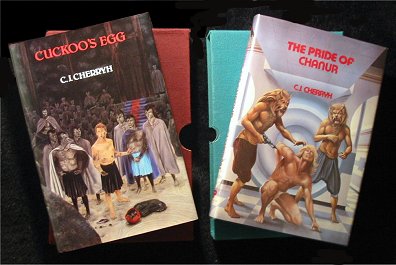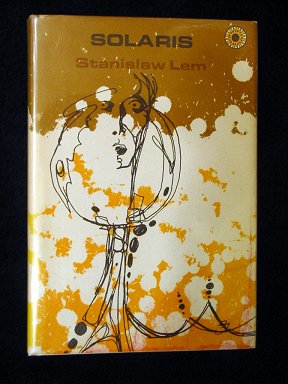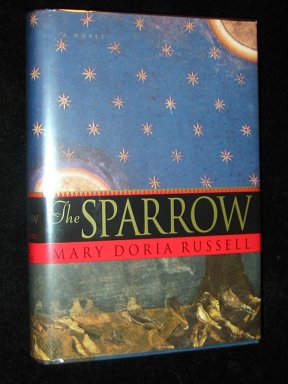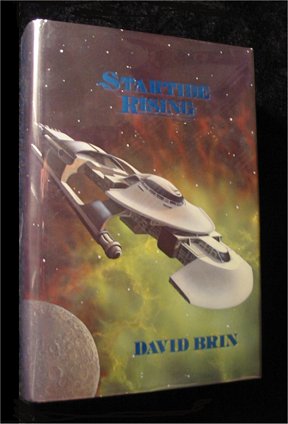

|
As an interesting example of how SF terms permeate popular culture, when astronomers discovered radio and optical signals that pulsed rapidly on and off, they were half-jokingly designated as BEM objects, alluding to the possibility that the signals were from alien civilizations. We now call these objects pulsars and understand them as a purely natural phenomena. In film, of course, there are countless aliens, from the shape-shifting monster in The Thing (see more below) and the noble Klaatu and the robot Gort of The Day the Earth Stood Still (based on the short story "Farewell to the Master" by Harry Bates), to the gentle ET who wants to go home and Sigourney Weaver's Alien who wants you for dinner. In fact, aliens are such pervasive staples of SF that Isaac Asimov's Foundation novels stand out as an oddity in their depiction of a galaxy in which humans are the only intelligent species - unless you count the robots. In The War of the Worlds (London: William Heinemann, 1898) H.G. Wells writes of the invasion of Earth by Martians, aliens with "intellects vast, cool and unsympathetic" but whose mighty war machines ultimately prove no match for terrestrial bacteria. The story was first serialized in Pearson's Magazine in 1896 and published in book form in 1898. On Halloween, 40 years later, Orson Welles panicked the nation with a Mercury Theatre radio adaptation set in Grover's Mill, New Jersey. A remarkably good movie version, featuring special effects by the legendary George Pal, was released in 1953, and a rock-opera version was released in 1978, written by Jeff Wayne and featuring Richard Burton as The Narrator, as well as a cast of rock performers which included Justin Heyward of The Moody Blues. The concept that the Welles radio broadcast documented a real invasion which was somehow covered up is key to the SF cult movie Buckaroo Banzai and to the War of the Worlds television series. The idea even made a cameo appearance in an X-Files episode in which a group of old men in Grover's Mill reminisce about the time they fought off the Martian war machines back in '38. SF aliens through the first half of the 20th century were typically monsters bent on invasion and destruction or people just like us in shiny suits. One of the first writers to make aliens seem truly alien was Stanley G. Weinbaum. His short story "A Martian Odyssey" (Wonder Stories, July 1934) is generally credited as one of the earliest depictions of an entire alien ecology populated with believable alien characters. The story had a profound effect on subsequent SF, which makes Weinbaum's untimely death at age 33 that much more tragic.
C.J. CherryhAlienation is a major, recurrent theme in C.J. Cherryh's writing: the realization that each of us is somewhat of an alien to our fellow humans. Or, to paraphrase Pogo: "We have met the alien, and he is us!" The concept of an indwelling alien nature is also a major thread in such classic McCarthy-era SF stories as Jack Finney's Invasion of the Body Snatchers (N.Y.: Dell No. 42, 1955, PBO; $25 - $40) and John W. Campbell's Who Goes There? (Chicago,: Shasta Publishers, 1948; $250 - $350; filmed multiple times as The Thing). These stories and the movies they inspired dovetailed into the theme of alienation neatly with the anti-Communist paranoia of the time. Alienation and paranoia figure prominently in nearly all of Cherryh's writing. The protagonist may be either figuratively or literally alien - an individual alienated among his own kind or alone in the company of aliens. The three best examples of the latter are Cuckoo's Egg and the Foreigner and Chanur series, in which the main human character spends most of the story immersed in one or more alien cultures, and his survival depends quite simply on unlearning his human ways and, in the words of SF author Rebecca Ore, becoming alien. An interesting analogy may be drawn with real-life ethnographic accounts of anthropologists living among the subjects of their study and with actual and fictional adventures along the lines of T.E. Lawrence's (Lawrence of Arabia) experiences in the Middle East. Cherryh is so successful in bringing us along on these cross-cultural journeys that, when "normal" humans make their appearance, it is they whose motivations and behavior seems bizarre and alien, not the Shonunin, the hani or the atevi (not to mention the st'sho, the mahendo'sat, the kif, various methane-breathers ... well, you get the idea). For a similar treatment of the psychology and politics of human/alien interaction, see Mary Gentle's Golden Witchbreed (London: Victor Gollancz, 1983; $15) and Ancient Light (London: Victor Gollancz, 1987; $10).

Compact Space - the Chanur series The Pride of Chanur (NY: Daw, 1981; PBO <$5)(West Bloomfield: Phantasia, 1987; Signed, limited to 350, numbered in slipcase $75+; trade edition limited to 900 $35+) Chanur's Venture (NY: Daw, 1984; PBO <$5)(West Bloomfield: Phantasia, 1984; Signed, limited to 350, numbered in slipcase $50; trade edition limited to 2000 $10+) The Kif Strike Back (NY: Daw, 1986; PBO <$5)(West Bloomfield: Phantasia, 1985; Signed, limited to 350, numbered in slipcase $50+; trade edition limited to ??? $25+) Chanur's Homecoming (NY: Daw, 1987; PBO <$5)(West Bloomfield: Phantasia, 1986; Signed, limited to 350, numbered in slipcase $50+; trade edition limited to ??? $25+) Chanur's Legacy (NY: Daw, 1992; Trade HB <$5)(No Phantasia Press edition) Note: The Chanur series is quite popular, and the hardback SFBC editions make nice reading copies that as a set might well fetch $20 at auction in Fine condition. Pyanfar Chanur, lion-like hani captain of the merchant ship Pride of Chanur, had no idea of the trouble to come when she offered sanctuary to the naked, wounded creature caught trying to enter her ship. For not only is he from an alien species unknown to the many members of the Compact, but also Pyanfar learns that this Tully-creature was crew of an exploration ship that blundered into kif territory and that the kif captured the ship and tortured the alien crew to learn all they could of this new space-faring power. Tully is the last survivor, and after he escapes to the dockside at Meetpoint Station, the kif are desperate to get him back; reason enough by itself for Pyanfar not to give him up. But time is running out. Power-hungry kif threaten to shatter the Compact, the methane-breathers are acting more insane than normal, and more of the alien human ships will be coming - straight into the teeth of the kif. Cuckoo's Egg (Huntington Woods, Michigan: Phantasia Press, 1985). What if a human child was raised and educated as an alien in an alien culture? Perhaps more importantly, what purpose might this serve? Cuckoo's Egg answers both of these questions in the story of the human child, Thorn, raised to adulthood among the Shonunin in complete ignorance of his origins or of why he is different from everyone else. Duun, a Shonunin hatani (a kind of warrior/judge/priest), is Thorn's teacher, and the bulk of the book explores the love/hate relationship between the two as Duun tries to prepare Thorn for a destiny that may destroy them both. Thorn's origins and the role he is to play in the future of the Shonunin is revealed in a rapid-fire ending that raises as many questions as it answers. Foreigner series
Foreigner (New York: Daw Books, 1994; $5) Two hundred years have passed since the human colony ship Phoenix, hopelessly lost after a navigation accident, discovered a planet inhabited by the pre-industrial atevi. After building a space station in orbit and offloading the colonists, the Phoenix crew left the atevi system. Voting to abandon the station, the colonists took one-way passage down to the planet, where they established a small enclave on the island of Mospheira. The struggling human colony established trading ties with a powerful atevi faction on the nearby mainland, exchanging technology for food and other needed items. But the rapid influx of technology shifted the balance of power with rival factions; this, compounded by several crucial fundamental misunderstandings between the two species, resulted in a brief but very bloody war that threatened the human colony with extinction. In the aftermath, the role of paidhi was created by treaty. The paidhi is a human who is designated as the sole point of contact between the two species and is a cross between translator, cultural anthropologist, economist, politician, diplomat and ambassador. Paidhi Bren Cameron finds himself cut off from Mospheira after he survives an assassination attempt, an attempt that disturbed his atevi hosts mainly because it was not properly registered with the Assassins Guild. Alone in a culture where a simple invitation to tea may or may not be fatal, Cameron knows that his own survival is linked to the survival of every human on the planet.
Stanislaw LemOne of the true landmark SF novels of the 20th century, Polish author Stanislaw Lem's Solaris (New York: Walker, 1970; $1500 - $2000+) has been made into a film twice, most recently in 2002, starring George Clooney. It is the story of an isolated research station on the ocean-planet Solaris and the events leading to the discovery that the ocean is in fact a single world-spanning sentient organism that is attempting to communicate with the scientists by accessing their memories and manipulating their reality. The story is a powerful exploration of human nature and of perception versus reality. Because it was written in a very sparse style without much of the technological "clutter" typically associated with SF, the story has aged remarkably well, and the human element, which is the main focus of the novel, still shines. Solaris and Lem have earned a well-deserved reputation among critics and readers outside of the SF genre.

Mary Doria RussellMary Doria Russell burst onto the SF scene in 1998 with the publication of her first novel, The Sparrow (New York: Villard, 1998; $25 - $50). Identifying the true first edition of this title is complicated by the fact that Villard is a Random House imprint, and so the first printing shows a number line that counts down to 2 (not 1) along with the phrase "First Edition." The following first issue points have been catalogued: 1) on page 16 the word "karstic" is printed instead of "karst"; 2) on page 95 the phrase "thirty two feet per second" appears instead of the correct "thirty two feet per second per second"; 3) the rear inner fold of the dust jacket shows the photographer credit to Dina Ross, later corrected to Dina Rossi. This title was heavily remaindered, and editions with the remainder mark carry little value. The story chronicles the voyage of a scientific expedition led by Jesuit linguist Emilio Sandoz. Sandoz is sent to investigate the source of an obviously artificial set of radio signals. The journey begins in a fervor of scientific curiosity and optimism and ends in a tragedy of inter-species misunderstanding so profound it threatens Sandoz' faith. Or, as my favorite Abebooks description puts it: "Jesuits head off on first contact mission and everything gets screwed up." A sequel was written called Children of God, and there are persistent rumors of a movie.

David Brin - Uplift UniverseSundiver (New York: Bantam Books, 1980; <$5) PBO, no hardback edition has yet been published. Startide Rising (New York: Bantam, 1983; PBO <$5) (West Bloomfield: Phantasia, 1987 - Signed, limited to 375, numbered in slipcase $250 - $400+; trade edition limited to 1575 $100+) The Uplift War (New York: Bantam Books, 1987; PBO <$5) (West Bloomfield: Phantasia, 1987 - Signed, limited to 475, numbered in slipcase $100+; trade edition limited to 3000 $50+) Brightness Reef (New York: Bantam Books, 1995; $5)(Norwalk: Easton Press, 1995; signed leatherbound, $100+) Infinity's Shore (New York: Bantam Books, 1996; $5)(Norwalk: Easton Press, 1996; signed leatherbound, $50 - $75) Heaven's Reach (1998) (New York: Bantam Books, 1998; $5)(Norwalk: Easton Press, 1998; signed leatherbound, $75+) David Brin's Uplift Universe has a simple but incredibly powerful central conceit. All intelligent species (and there are tens of thousands of them) have had a Patron species that raised them to sentiency through the process of Uplift - all except for the humans of Earth. In a Universe where prestige, power and politics is tied to the Uplift lineage your species belongs to, the wolfling humans are virtually without position or protection. It was only the programs of genetic manipulation that resulted in human-level sentience among the dolphin and chimpanzee species prior to first contact that gave humanity any status in the Five Galaxies community, and there are many powerful enemies who want to revoke Earth's status and seize them as a client species. The anti-Earth factions claim that humanity could not have developed intelligence independently and so must have a hidden Patron who has abandoned the species, most likely out of embarrassment. Of course, this begs the whole chicken-and-egg question: if an intelligent species is required to uplift an intelligent species, then where did the first intelligent species come from? The various species have many and conflicting stories of these semi-mythical Progenitors, and when the human/dolphin research vessel Streaker discovers the location of a derelict fleet of Progenitor ships, it becomes the ultimate prize as the Five Galaxies teeter on the brink of war.

Vernor VingeA Fire Upon the Deep (NY: Tor, 1992; $50 - $75)(Norwalk, CT: Easton Press, 1992; signed limited leather; $150). A huge, complex novel that defies any effort to sum it up in one sentence. Notable in this context for the wonderfully written Tines, a race of dog-like aliens whose individual members are no more than animals. A pack of Tines combines into a telepathically-linked gestalt mind that thinks of itself as a single personality. Deepness in the Sky (New York: Tor, 1999; $5). A prequel to A Fire Upon the Deep featuring a race of spider-like aliens that have evolved on a planet orbiting a variable "On/Off" star. A well-realized description of the biology and culture that could develop on a world that goes into deep-freeze every few decades. Interesting comparison to Cycle of Fire by Hal Clement (see below).
Hal Clement (pen name Harry Clement Stubbs)Needle (Garden City: Doubleday, 1950; $50 - $75). An alien detective hunts a criminal on Earth. The catch is both hunter and hunted are protoplasmic organisms that need to inhabit host bodies. Mission of Gravity (Garden City: Doubleday, 1954; $300 - $400). Classic hardcore SF tale of a race of intelligent caterpillars that have evolved on Mesklin, an unusual planet with a surface gravity that ranges from three times Earth's normal gravity at the equator to hundreds of G's at the poles. Cycle of Fire (New York: Ballantine Books, 1957 PBO; $5 and London. Victor Gollancz, 1964; $75+). A stranded human and alien native must cooperate in order to survive the coming massive heat wave. Reminiscent of Weinbaum's "A Martian Odyssey".
Robert ForwardDragon's Egg (New York: Ballantine Books, 1980; $25+). Hardcore SF about the evolution of intelligent life on the surface of a neutron star. Often compared to Clement's Mission of Gravity (see above).
< to previous article
Questions or comments?
| Forum
| Store
| Publications
| BookLinks
| BookSearch
| BookTopics
| Archives
| Advertise
| AboutUs
| ContactUs
| Search Site
| Site Map
| Google Site Map
Store - Specials
| BookHunt
| BookShelf
| Gold Edition & BookThink's Quarterly Market Report
| DomainsForSale
| BookThinker newsletter - free
Copyright 2003-2011 by BookThink LLC
|

|